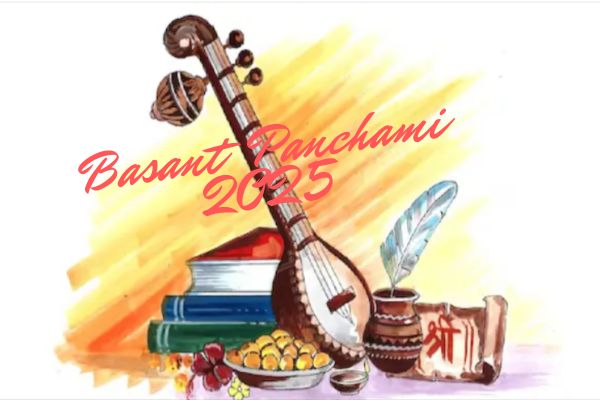
Basant Panchami: The Festival of Knowledge, Wisdom, and New Beginnings
Basant Panchami, also known as Vasant Panchami, marks the arrival of spring in India. Celebrated with great enthusiasm, this festival holds deep cultural, spiritual, and seasonal significance. Dedicated to Goddess Saraswati, the deity of wisdom, learning, and arts, Basant Panchami is a day when people seek knowledge, embrace new beginnings, and indulge in festive celebrations.
The Significance of Basant Panchami
Basant Panchami is observed on the fifth day (Panchami) of the Hindu month of Magha, usually falling in late January or early February. The festival is associated with Goddess Saraswati, who symbolizes wisdom, knowledge, music, and the creative arts. Schools, colleges, and educational institutions across India organize special pujas, and students place their books and instruments at the feet of the goddess, seeking her blessings.
Seasonal Importance
Basant Panchami also heralds the arrival of spring, a time of renewal and prosperity. The mustard fields bloom with golden flowers, signifying the color yellow, which dominates the festival’s theme. People wear yellow clothes, prepare yellow sweets like Kesari Halwa and Sweet Saffron Rice, and offer yellow flowers to the goddess.
How is Basant Panchami Celebrated?
1. Worship of Goddess Saraswati
On this day, devotees set up altars and offer white and yellow flowers, books, and musical instruments to Goddess Saraswati. Schools and educational institutions perform Saraswati Puja, and students refrain from reading or writing for the day as a mark of respect.
If you’re planning to perform Saraswati Puja at home, check out this beautiful Saraswati Idol & Puja Kit on Amazon.
2. Wearing Yellow Attire
People dress in yellow, representing energy, prosperity, and wisdom. Women and girls often wear yellow sarees and salwar suits, while men opt for yellow kurtas.
Get a traditional Yellow Saree or Men’s Kurta for Basant Panchami on Amazon.
3. Flying Kites
In many parts of North India, especially Punjab and Haryana, kite flying is a major attraction. The sky is filled with colorful kites, symbolizing joy and freedom.
Buy high-quality kites and manja (kite string) for the festival on Amazon.
4. Traditional Sweets and Food
Food is a major part of Basant Panchami celebrations. Families prepare Kesari Halwa, Puran Poli, Kesar Kheer, and Boondi Laddoo to mark the occasion.
Order ready-to-make kesari halwa mix or saffron (kesar) to enhance your festive sweets on Amazon.
5. Recipes for Basant Panchami
Here are some traditional dishes prepared on this auspicious day:
- Kesari Halwa – A delicious saffron-infused semolina dessert.
- Sweet Saffron Rice – Made with rice, saffron, cardamom, and nuts.
- Puran Poli – A sweet flatbread stuffed with lentil and jaggery filling.
- Boondi Laddoo – Small fried gram flour balls soaked in sugar syrup.
Get all the essential ingredients for festive cooking on Amazon.
6. Initiation of Education (Vidyarambh Sanskar)
Many parents introduce young children to education by making them write their first letters in front of Goddess Saraswati. This practice, known as Vidyarambh Sanskar, is considered auspicious.
Check out Saraswati Puja Storybooks for children on Amazon.
Regional Variations of Basant Panchami Celebrations
West Bengal
In Bengal, Basant Panchami is celebrated as Saraswati Puja, where students and artists seek blessings for success. Pandals are set up, and young girls wear yellow sarees as they pray to the goddess.
Punjab & Haryana
In Punjab and Haryana, kite flying is an integral part of the celebrations. People gather on rooftops and indulge in friendly kite-flying competitions.
Rajasthan
In Rajasthan, people decorate their homes with yellow flowers, and families organize feasts with dishes made from saffron and turmeric.
Uttar Pradesh & Bihar
Educational institutions conduct grand Saraswati Pujas, and sweet saffron rice is prepared in homes.
Spiritual & Astrological Importance of Basant Panchami
Basant Panchami is also considered an auspicious day for marriages and new ventures. Many people believe that the day brings positivity, making it ideal for starting new businesses, purchasing homes, or performing religious ceremonies.
Astrological Significance:
- The festival is linked to the planet Jupiter (Guru), symbolizing wisdom and expansion.
- It is one of the few days in the Hindu calendar where a muhurat (auspicious time) is not required for significant life events.
FAQs on Basant Panchami
Q1: When is Basant Panchami celebrated in 2025?
A: Basant Panchami will be celebrated on February 2, 2025.
Q2: Why do people wear yellow on Basant Panchami?
A: Yellow is associated with wisdom, prosperity, and spring. It symbolizes energy and positivity, making it the dominant color of the festival.
Q3: What are the traditional foods of Basant Panchami?
A: Dishes like Kesari Halwa, Kesar Kheer, Sweet Saffron Rice, and Boondi Laddoo are commonly prepared.
Q4: Can non-Hindus celebrate Basant Panchami?
A: Absolutely! Basant Panchami is a festival of knowledge and new beginnings, and anyone can take part in its celebrations, irrespective of religion.
Q5: Is Basant Panchami a public holiday?
A: It is a holiday in some Indian states, particularly in educational institutions where Saraswati Puja is performed.
Q6: How is Basant Panchami different from Holi?
A: While both festivals celebrate spring, Basant Panchami is dedicated to Goddess Saraswati, whereas Holi is a festival of colors and joy.
Conclusion
Basant Panchami is a beautiful festival that blends devotion, wisdom, culture, and joy. Whether you’re worshiping Goddess Saraswati, flying kites, preparing delicious sweets, or wearing bright yellow, the essence of the festival remains the same—celebrating knowledge, prosperity, and new beginnings.
Make this Basant Panchami special by indulging in traditional celebrations and embracing the festival’s vibrant energy. Happy Basant Panchami! 🌼🎶✨




